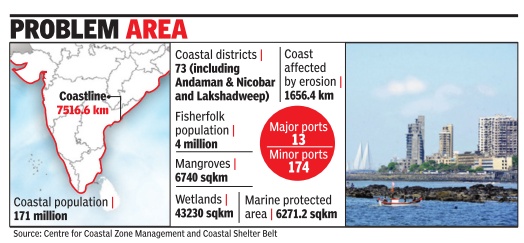Coastline, beaches: India
This is a collection of articles archived for the excellence of their content. |
Indian coastline under threat
The Times of India, Aug 05 2015

Subodh Varma
Cash-strapped authorities put coastline under threat
Construction, erosion top worries: Panel
India's 7500 km long coast line, home to over 171 mil lion people, is under threat and the government machinery meant to manage it is in disarray . The coastal zone management authorities (CZMA 's) at the national and state level are orphaned bodies with no financial support, except what they raise by charging fees from those wanting project clearance. They are packed with ex-officio bureaucrats from various departments with limited expertise.Their meetings are spent in discussing project applications. They clear 80% of projects but never go back to monitor or check violations. They don't have maps with requisite details. They have not even marked out the high tide line. These are the shocking findings of a report prepared by a group of environmental activists cum experts from the Centre for Policy Research, New Delhi and the Namati Environmental Justice Program. The authors interviewed sitting and ex-members of the CZMAs, analysed minutes of 350 meetings of the CZMAs and looked at high court and National Green Tribunal cases over the years.
By a 1991 government notification, the coast is divided into four zones -one stretches over the water while three stretch landwards going up to 500 meters from high tide level. Multiple, contesting us es are vying for a piece of the coastindustries, real estate, tourism, livelihoods, mining and conservation, says Meenakshi Kapoor, one of the researchers.
“There are threats from unregulated construction, discharge of untreated effluents and sewage, destruction of mangroves, deterioration of critical ecosystems such as estuaries, saltpans, coral reefs, etc and coastal erosion,“ she said.
In most coastal Indian cities, poorer sections are forced to live in slums on the coast. Municipal authorities allow destruction of natural drainage and wetlands, as in Mumbai, causing flooding.Over 90% of sewage pouring into the sea from 87 big cities is untreated.
It was to regulate and monitor these threats that the coastal zones were notified and CZMAs were set up. On paper there are strict rules about where you can build a hotel or an ice factory , and where you can have fish processing units or net mending yards. And, the CZMAs are supposed to keep a tight watch. But the reality is reverse.
The report narrates in harrowing detail their analysis of 350 meeting minutes of national and state CZMAs. The NCZMA discussed 157 agenda items between 2003 and 2013 of which 73 related to reclassifying a piece of the coast so that it can be used differently . Just 12 cases of violations and just one case of reviewing what the state CZMAs were doing was discussed.
The state CZMAs were initially given Rs 5 lakh each by the central environment ministry . After that they have been left to their own de vices till 2011 when state governments were asked to fund them. Meanwhile each state CZMA has hammered out its own way of raising funds.
In Goa, if you want to set up a commercial institution, you apply to the Goa CZMA and pay Rs 10,000 fees. For setting up anything worth upto Rs 5 crore, you pay processing fees of Rs 25,000 in Gujarat, Rs 1 lakh in Maharashtra or just Rs 10,000 in West Bengal. Since the money is coming from project proposals, maximum time is spent by the state bodies discussing them. In Kerala, Karnataka, Maharashtra and Odisha, over 90% of the agenda items were project proposals.
In other states, this frequency was between 60 to 80%, with only Goa having 46% frequency , according to analysis of meeting minutes between 2010 and 2013.
The report recommends an overhaul with better definition of roles and powers, more resources, participatory planning, bringing in transparency , and improving monitoring and compliance. Otherwise, this bureaucratic mess will be unable to save India's coasts.